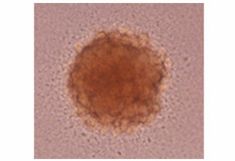Lukas Mach
Molekulare Zellbiologie
Research interests
Research interests
Biosynthesis and intracellular trafficking of secretory and lysosomal/vacuolar proteins, glycosylation and other post-translational protein modifications as determinants of protein structure and function, catalytic properties and physiological functions of proteases and glycosylation enzymes, proteolysis and its pathological and biotechnological relevance, recombinant expression of biotherapeutics in plants, plant membrane protein biochemistry.
Principal investigator: Univ.Prof. DI Dr. Lukas Mach
Projects
Our current research interests are focussed on the following topics:
- Biosynthesis and intracellular trafficking of secretory and lysosomal/vacuolar proteins
- Glycosylation and other post-translational protein modifications as determinants of protein structure, function and fate
- Catalytic properties and physiological functions of proteases and glycosylation enzymes
- Proteolysis and its pathological and biotechnological relevance
- Plant-based expression platforms for the production of complex biopharmaceuticals
- Structural features of plant hormone transporters and hormone-binding proteins
Examples for ongoing research activities:
- Deciphering of the molecular basis for the anti-metastatic activity of M6P/IGF2R
- Elucidation of the physiological functions of the lysosomal/vacuolar protein CREG
- Plant-derived proteases and their impact on recombinant protein production
- Biochemical characterization of auxin transporters and auxin-binding proteins
Deciphering of the molecular basis for the anti-metastatic activity of M6P/IGF2R:
The mannose 6-phosphate/insulin-like growth factor II receptor (M6P/IGF2R) is a multifunctional tumour suppressor which binds a variety of factors that impinge on the proliferation, migration and invasiveness of cancer cells. Hence, it is of high relevance that the M6P/IGF2R gene is frequently inactivated in human and animal tumours. However, the impact of M6P/IGF2R on tumour invasion and metastasis is so far only poorly understood. We have now demonstrated that reconstitution of functional M6P/IGF2R expression in receptor-deficient murine cancer cells severely compromises their invasive potential. These results indicate that the M6P/IGF2R status influences the metastatic propensity of cancer cells in a decisive manner.
It is still unknown which ligands account for the anti-metastatic activity of M6P/IGF2R. As a step towards their identification, we have recently established the individual importance of the different ligand-binding sites of the receptor for its anti-invasive properties. These studies have revealed that the interaction between M6P/IGF2R and M6P-modified ligands is more important for tumour suppression than its capacity to limit the bioavailability of IGF2. Future studies will aim at the identification of these anti-invasive M6P-modified protein(s) followed by a comprehensive assessment of their involvement in tumour invasion and metastasis.
Elucidation of the physiological functions of the lysosomal/vacuolar protein CREG:
In our search for potentially tumour-suppressive M6P/IGF2R interaction partners, we identified an essentially uncharacterized M6P-modified protein previously named Cellular Repressor of E1A-stimulated Genes (CREG). CREG is a glycoprotein expressed in most mammalian tissues and cell types. We have investigated its subcellular localization in mammalian cells, Drosophila melanogaster and Arabidopsis thaliana and found that intracellular CREG resides in all these organisms within lysosomes or its functional equivalents. In mammals, transport of CREG to these compartments was shown to rely on the M6P receptor pathway as typical for soluble lysosomal proteins. The intracellular form of CREG was found to lack an N-terminal peptide present in the secreted protein. These results establish that CREG is a lysosomal protein that undergoes proteolytic maturation in the course of its biosynthesis, carries the M6P recognition marker and depends on the interaction with M6P receptors for efficient delivery to lysosomes.
Considerable evidence has been provided that CREG is involved in the control of cell growth and differentiation. However, the biochemical basis for its cellular activities has not been unravelled so far. To gain more insights into the physiological functions of CREG, we have performed knock-down experiments in D. melanogaster and found that depletion of this protein leads to severe developmental defects. This is accompanied by an impaired autophagic response to starvation. Future work will aim at the generation of a mouse model with a conditional disruption of the CREG gene to study the role of this protein in autophagy and development. These studies will provide new insights into lysosome biology and thus improve our understanding of disease states associated with lysosomal dysfunctions such as cancer.
Plant-derived proteases and their impact on recombinant protein production:
Several studies have demonstrated that plants are suitable hosts for the production of protein biopharmaceuticals. However, the generation of recombinant monoclonal antibodies in plants is frequently hampered by unwanted proteolysis. This is also the case for Nicotiana benthamiana, a tobacco-related plant species emerging as a rapid and versatile expression host for complex recombinant proteins. In a recent study, we have obtained evidence that fragmentation of antibodies in N. benthamiana involves the action of serine and cysteine proteases. We have therefore commenced a systematic evaluation of the antibody-degrading potential of N. benthamiana serine and cysteine proteases, with particular emphasis on a proteomics-based assessment of their substrate preferences. These studies have already resulted in the comprehensive characterization of several enzymes displaying antibody-degrading activity. Future efforts will be directed at the prevention of antibody proteolysis in N. benthamiana by removing or inhibiting selected proteinases using both genome-editing and gene-silencing approaches, with the ultimate aim of improving N. benthamiana as an expression platform for recombinant proteins.
For further insights into the molecular mechanisms governing proteolytic degradation of biopharmaceuticals in plants, we have recently embarked on a systems-based approach to characterize the genomic and transcriptomic landscape of N. benthamiana. In collaboration with other BOKU groups, we have acquired genomic and transcriptomic next-generation sequencing datasets of the N. benthamiana line commonly used for recombinant protein production. These data are currently used for the genome-scale identification of protease genes and an assessment of their transcriptional status. In the future, functional analysis of the N. benthamiana genome will be extended to additional gene families of biotechnological interest such as glycosyltransferases, glycosidases and other enzymes engaged in post-translational modifications of secretory proteins.
Biochemical characterization of auxin transporters and auxin-binding proteins:
Auxin is a major plant hormone that is involved in practically all aspects of plant existence. A fundamental feature of auxin is that it has to be properly transported and redistributed throughout the plant at all stages of a plant’s life cycle. The proteins involved in controlling and directing this transport are thus key determinants of plant growth. The PINs are a family of polytopic membrane protein transporters that play a crucial role in the directional export of auxin from plant cells, but the actual mode of action by which they do this is unknown. We are using biochemical approaches to elucidate some basic structural features of PIN proteins, in particular oligomerisation, which is a recurring feature of many membrane transporters, and phosphorylation, which plays a role in transport activity as well as determining the localisation of PINs in the cell. We are also exploiting phylogenetics to better understand the molecular properties of PINs and PIN-related proteins.
Auxin Binding Protein 1 (ABP1) is a cupin-type protein located predominantly in the endoplasmic reticulum of plant cells. Due to its high affinity for auxin it has been implied in different auxin-dependent responses. However, the once postulated role of ABP1 as an auxin receptor is now refuted as the abp1 mutant is apparently quite a normal plant and does not have the severe phenotype that was originally reported. We are investigating the molecular mechanisms as to how ABP1 may respond to and signal the presence or absence of auxin, with the aim of establishing the precise molecular function of ABP1.


Representative recent research publications
1. Probst, O.C., Karayel, E., Schida, N., Nimmerfall, E., Hehenberger, E., Puxbaum, V. and Mach, L. (2013) The mannose 6-phosphate binding sites of M6P/IGF2R determine its capacity to suppress matrix invasion by squamous cell carcinoma cells. Biochem. J. 451, 91-99
This paper reports on the biological properties of mannose 6-phosphate/insulin-like growth factor II receptor (M6P/IGF2R) mutants individually lacking one of its diverse ligand-binding activities. Opposite to current belief, we demonstrate that the interaction of the receptor with as yet unidentified M6P-modified ligands has a stronger biological impact than its sequestration of IGF2. Hence, the generation of these mutant cell lines sets the stage for further studies on the tumour-suppressive and anti-metastatic capacity of M6P/IGF2R.
2. Kowalewski-Nimmerfall, E., Schähs, P., Maresch, D., Rendic, D., Krämer, H. and Mach, L. (2014) Drosophila melanogaster Cellular Repressor of E1A-stimulated Genes is a lysosomal protein essential for fly development. Biochim. Biophys. Acta 1843, 2900-2912
In the course of our search for tumour-suppressive M6P/IGF2R ligands, we have identified a novel lysosomal protein of hitherto unknown function: Cellular Repressor of E1A-stimulated Genes (CREG). In this paper, we report that genetic downregulation of CREG leads to severe developmental defects in the model organism Drosophila melanogaster. These results warrant a closer look at the potential role of CREG in human diseases such as lysosomal storage disorders or cancer.
3. Niemer, M., Mehofer, U., Torres Acosta, J.A., Verdianz, M., Henkel, T., Loos, A., Strasser, R., Maresch, D., Rademacher, T., Steinkellner, H. and Mach, L. (2014) The human anti-HIV antibodies 2F5, 2G12 and PG9 differ in their susceptibility to proteolytic degradation: downregulation of endogenous serine and cysteine proteinase activities could improve antibody production in plant-based expression platforms. Biotechnol. J. 9, 493-500
Recombinant proteins produced in plant-based expression platforms such as Nicotiana benthamiana often suffer from unintended proteolysis in planta and during post-harvest settings. The proteinases involved in these degradative processes are still unidentified. This study has revealed that serine and cysteine proteinases account for the fragmentation of monoclonal antibodies in the apoplast of N. benthamiana. We also present evidence that specific structural elements of the respective variable domains determine the proteolytic sensitivity of antibodies in plants.
4. Loos, A., Gach, J.S., Hackl, T., Maresch, D., Henkel, T., Porodko, A., Bui-Minh, D., Sommeregger, W., Wozniak-Knopp, G., Forthal, D.N., Altmann, F., Steinkellner, H. and Mach, L. (2015) Glycan modulation and sulfoengineering of anti-HIV-1 monoclonal antibody PG9 in plants. Proc. Natl. Acad. Sci. USA 112, 12675-12680
Many therapeutically effective antibodies against HIV-1 contain sulfated tyrosine residues in their antigen-binding regions. In this study, we demonstrate that this post-translational modification is critical for the antigen-binding activity of the anti-HIV-1 antibody PG9. Simultaneous co-expression of PG9 and human tyrosylprotein sulfotransferase in Nicotiana benthamiana resulted in a derivative with vastly improved antigen recognition. Importantly, the effector functions of this plant-made PG9 variant were superior to its counterpart produced in mammalian cells.
5. Biniossek, M.L., Niemer, M., Maksimchuk, K., Mayer, B., Fuchs, J., Huesgen, P.F., McCafferty, D.G., Turk, B., Fritz, G., Mayer, J., Haecker, G., Mach, L. and Schilling, O. (2016) Identification of protease specificity by combining proteome-derived peptide libraries and quantitative proteomics. Mol. Cell. Proteomics 15, 2515-2524
Many proteases interact with their substrates through multiple subsites. For reliable prediction of a protease’s potential targets, a comprehensive assessment of its subsite preferences is required. In recent years, degradomics approaches based on proteome-derived peptide libraries have become the method of choice for substrate profiling of proteases. In this paper, we report a new MS-based method for the rapid identification and quantitation of substrate peptides and their cleavage products. In future studies, this method will be used to decipher complex proteolytic events such as those leading to the degradation of recombinant proteins in plants.
6. Stadlmann, J., Taubenschmid, J., Wenzel, D., Gattinger, A., Dürnberger, G., Dusberger, F., Elling, U., Mach, L., Mechtler, K. and Penninger, J.M. (2017) Comparative glycoproteomics of stem cells identifies new players in ricin toxicity. Nature 549, 538-542
The plant toxin ricin is considered one of the most dangerous biological warfare agents. For its internalization, ricin has to bind to selected carbohydrate structures present on the surfaces of target cells. Employing a new glycoproteomics procedure, we have now identified the cell-surface glycoproteins carrying ricin-reactive oligosaccharides. These studies revealed that the presence of the mannose 6-phosphate/insulin-like growth factor II receptor (M6P/IGF2R) is an important determinant of the ricin sensitivity of mammalian cells.
Funding organisations
Current international collaboration partners
- Patrick Gallois (Manchester, UK)
- Brigita Lenarcic (Ljubljana, Slovenia)
- Andreas Schaller (Hohenheim. Germany)
- Oliver Schilling (Freiburg, Germany)


